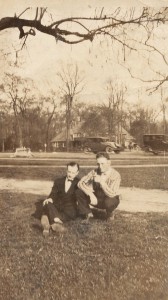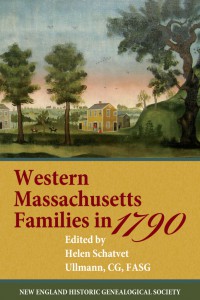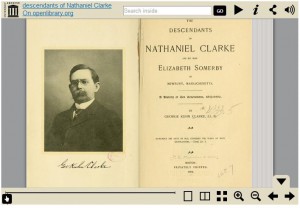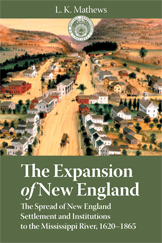 I am currently at work processing the Farley Family Papers, a large collection that includes hundreds of letters, photographs, estate records, and military records created by several generations of Farleys in Massachusetts. The wide variety of documents found in the collection creates a vivid picture of what life was like for this family. Among other things, this collection contains two long photographs, originally rolled together and stored in a tube, of the members of the Puddingstone Club, as well as letters from the club’s members to Arthur Christopher Farley (1851-1919). Continue reading “Check or cash … gratefully received”
I am currently at work processing the Farley Family Papers, a large collection that includes hundreds of letters, photographs, estate records, and military records created by several generations of Farleys in Massachusetts. The wide variety of documents found in the collection creates a vivid picture of what life was like for this family. Among other things, this collection contains two long photographs, originally rolled together and stored in a tube, of the members of the Puddingstone Club, as well as letters from the club’s members to Arthur Christopher Farley (1851-1919). Continue reading “Check or cash … gratefully received”
Monthly Archives: February 2014
Just how reliable is that source?

Many of us have been betrayed, genealogically speaking, by a source that appears to be reliable but is not. Often the source is reliable for the most part. But that fact gives you no comfort when the information in which you are interested turns out to be incorrect. Continue reading Just how reliable is that source?
Clear cutting in the genealogical forest
 When I was in school thirty plus years ago, there was a lot of discussion about the differences between history and genealogy – usually with genealogy getting the short end of the stick. The gap between historians and genealogists narrowed once we realized that we all use many of the same sources for similar ends. The differences are in our goals. The historian is trying to interpret the life of communities and does not really need to deal with the details of individuals. The genealogist is dealing with individuals on a fact-by-fact basis and may not feel the need to understand the larger community. To an historian a genealogist might appear to “not see the forest for the trees,” and to a genealogist an historian might “clear cut” the trees they have been nurturing in hopes of finding the forest! Continue reading Clear cutting in the genealogical forest
When I was in school thirty plus years ago, there was a lot of discussion about the differences between history and genealogy – usually with genealogy getting the short end of the stick. The gap between historians and genealogists narrowed once we realized that we all use many of the same sources for similar ends. The differences are in our goals. The historian is trying to interpret the life of communities and does not really need to deal with the details of individuals. The genealogist is dealing with individuals on a fact-by-fact basis and may not feel the need to understand the larger community. To an historian a genealogist might appear to “not see the forest for the trees,” and to a genealogist an historian might “clear cut” the trees they have been nurturing in hopes of finding the forest! Continue reading Clear cutting in the genealogical forest
Beautiful Detroit

A current research preoccupation of mine is a photo of my maternal grandfather, Arthur David Belforti (born Achille Alessio Riccardo Belforti, 1902-1996), which my mother recently gave me and which is pictured here. Having had a close relationship with this grandparent, I have always been particularly keen on researching his past and his branch of the family. There is no handwriting on the reverse of the photo, and my mother has no details about it. My first thought upon seeing it was that it might have been taken in or near Detroit. My reasons for believing this were several – 1) before my grandfather was married, he lived in the Detroit area for a couple of years around 1929, drawn there to work at Henry Ford’s newly opened and highly innovative River Rouge plant; 2) his apparent age in the photo seems to match up with that time period; 3) I didn’t recognize the person who sits next to him in the photo, and neither did my mother; and 4) we didn’t recognize the place. My grandfather lived in just three places during his life – Italy, Massachusetts, and Michigan. I’m pretty familiar with the first two, but not so much with the third. Continue reading Beautiful Detroit
First steps in Western Massachusetts research
 Although many Eastern Massachusetts colonial families have been well covered in print, the sons and daughters of those families who moved west are often lost to genealogists. The first stop on their migratory path was often in the woods of Western Massachusetts.
Although many Eastern Massachusetts colonial families have been well covered in print, the sons and daughters of those families who moved west are often lost to genealogists. The first stop on their migratory path was often in the woods of Western Massachusetts.
In many respects, Western Massachusetts is a different world from Boston and its environs. In the rural towns of Berkshire, Hampshire, Hampden, and Franklin Counties researchers can easily depart from the paved road in pursuit of a cemetery or family farm. Looking at the area via the satellite view on maps.google.com, Western Massachusetts appears to be mostly green forest, probably much of it rugged terrain, except for the major towns. Continue reading First steps in Western Massachusetts research
Using the NEHGS catalog from home
 Have you wished that you could use NEHGS library resources from home? Have you wondered where to find copies of genealogies online? You can do this by starting with the NEHGS library catalog. Staff and dedicated volunteers have been working to add links to freely available e-books as well as to genealogies and items from our manuscript and book collections for members to use. Continue reading Using the NEHGS catalog from home
Have you wished that you could use NEHGS library resources from home? Have you wondered where to find copies of genealogies online? You can do this by starting with the NEHGS library catalog. Staff and dedicated volunteers have been working to add links to freely available e-books as well as to genealogies and items from our manuscript and book collections for members to use. Continue reading Using the NEHGS catalog from home
Tips for online genealogical research
I frequently encounter eighteenth- or nineteenth-century dates, especially on the migration trail, that are not cited and which often derive from “online trees,” usually the FamilySearch Ancestral File, Rootsweb WorldConnect, or Ancestry World Tree. These days, I find it easier to determine whether any of the information is valid thanks to the many works and databases indexed at Google and Google Books. The following case suggests the variety of trails the researcher must be prepared to follow, from unverified online trees (which may hold important clues) to books and newspapers contemporary with the events mentioned (and which are sometimes flawed). Continue reading Tips for online genealogical research
The first year of the Early New England Families Study Project
 It is just a little over a year since NEHGS President and CEO Brenton Simons came to me with the idea for what became the Early New England Families Study Project. I was immediately interested, not only because it is an important institutional project, but because it brought me full circle to my beginnings in genealogy. My first job with NEHGS in the 1970s was to create a bibliography for Clarence Almon Torrey’s manuscript “New England Marriages Prior to 1700.” It took a number of years, with the help of colleague Peter Drummey, to compare Torrey’s short citations to the books in the library and decide which belonged to which. It was an unparalleled education in genealogical literature! Continue reading The first year of the Early New England Families Study Project
It is just a little over a year since NEHGS President and CEO Brenton Simons came to me with the idea for what became the Early New England Families Study Project. I was immediately interested, not only because it is an important institutional project, but because it brought me full circle to my beginnings in genealogy. My first job with NEHGS in the 1970s was to create a bibliography for Clarence Almon Torrey’s manuscript “New England Marriages Prior to 1700.” It took a number of years, with the help of colleague Peter Drummey, to compare Torrey’s short citations to the books in the library and decide which belonged to which. It was an unparalleled education in genealogical literature! Continue reading The first year of the Early New England Families Study Project
Westward migration from New England
 When searching for elusive New England ancestors, locating where they may have moved within New England or beyond is critical. For example, a genealogist might have traced his Michigan family back to, say, a great-great-great-grandfather in Batavia, New York, in 1820, but where was this family earlier? Continue reading Westward migration from New England
When searching for elusive New England ancestors, locating where they may have moved within New England or beyond is critical. For example, a genealogist might have traced his Michigan family back to, say, a great-great-great-grandfather in Batavia, New York, in 1820, but where was this family earlier? Continue reading Westward migration from New England
Locating genealogical manuscript collections in the U.S.
Working with the papers of so many prominent genealogists here at NEHGS, I’ve developed an interest in the history of genealogy in America. An offshoot of this personal research interest has been an informal effort to identify the repositories where various prominent genealogists donated their papers. Over the years, this interest has broadened to a general interest in identifying “sizeable” genealogical collections and the repository where they are preserved. Data from this personal interest has supported several projects of the NEHGS Special Collections and vice versa. Continue reading Locating genealogical manuscript collections in the U.S.